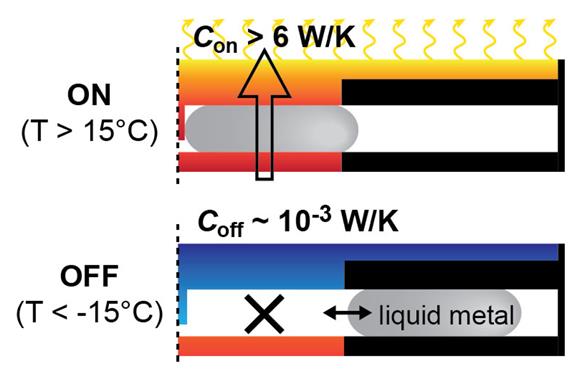Weisensee to develop heat transfer switch for NASA with early career award
Patty Weisensee will work on a liquid-metal-based heat transfer switch for NASA with an early career award

The electronic components of a spacecraft generate a tremendous amount of heat, which has to be safely dissipated into the atmosphere. Satellites, rovers and other space vehicles also face vast temperature changes while in space depending on their proximity and orientation to the sun, presenting challenges to the engineers who design them.
Patricia Weisensee, a mechanical engineer and materials scientists in the McKelvey School of Engineering at Washington University in St. Louis, plans to develop a liquid-metal-based heat switch that automatically turns on or off based on the external temperature with a three-year, $600,000 Early Career Award from NASA. The award is given annually to six to eight tenure-track assistant professors who demonstrate proof-of-concept of the proposed technology.
Weisensee, assistant professor of mechanical engineering & materials science, began her work on the switch as a doctoral student at the University of Illinois Urbana-Champaign and has filed with her co-researchers from Illinois for patent on that work. Building on that knowledge, she now plans to develop a thermal switch that uses a room-temperature liquid metal to connect or disconnect two thermal conductors, which would turn the heat transferability on or off, respectively. Unlike existing passive heat switches, which can be bulky, unable to be scaled or have moderate switching ratios, Weisensee's proposed switch is lightweight, compact and actuated passively by temperature, all things that NASA is seeking for its manned and unmanned space vehicles.
"The problem in space is depending on where you are or which direction you are facing, it's either very cold in the environment or it's very hot," Weisensee said. "The electronics don't like that, so NASA is looking for a mechanism to control the heat exchange between the internal parts of the satellite or space vehicle and the external environment. The beauty of this passive switch that I am working on is that it potentially can be integrated with flexible materials, so you're killing two birds with one stone."
She is working with Washington University's Office of Technology Management to patent the new technology.
Weisensee will use gallium-based alloys for the liquid metal because they have the lowest melting point of all metals, except for mercury; a very high thermal conductivity compared to most other liquids; are thermally and chemically stable, and are highly adaptable. At temperatures above 15 C, the metal will be liquid and connect the heat source to the heat sink and will turn the switch on. At temperatures below 15 C, the metal will disconnect the inner components of the vehicle with the shell and turn the switch off.
However, she said, gallium-based alloys are very corrosive to other metals and can eat through other metals, which harms the structural integrity. To combat that, Weisensee is working with Srikanth Singamaneni, professor of mechanical engineering & materials science at WashU, to create a coating that would keep the structural materials from corroding.
"This would also be relevant for thermal management of batteries in electric cars and could potentially be integrated with wearable electronics due to its high conformity and compact and lightweight design," she said.




